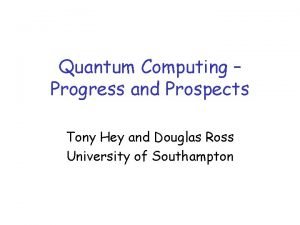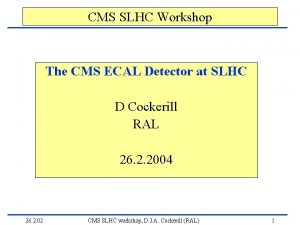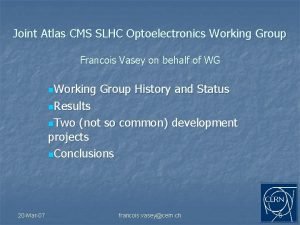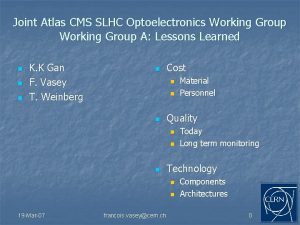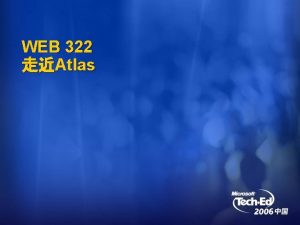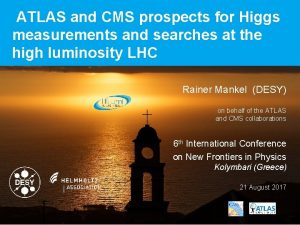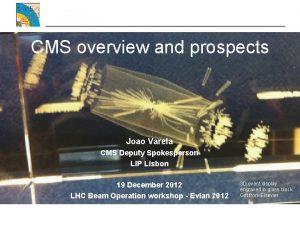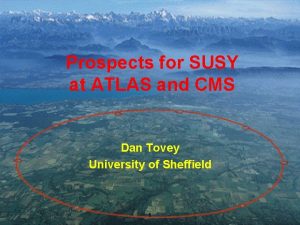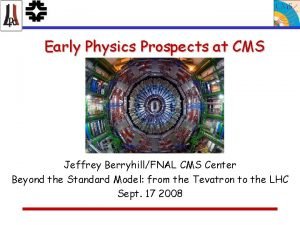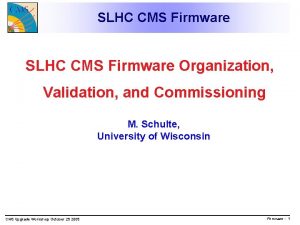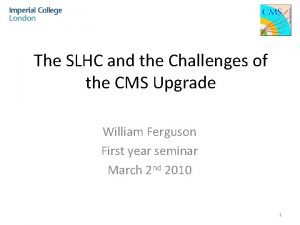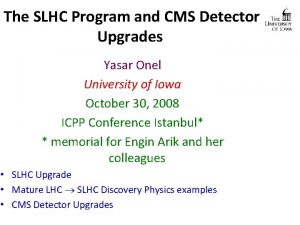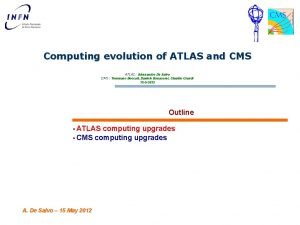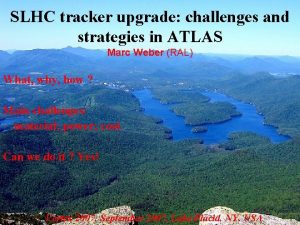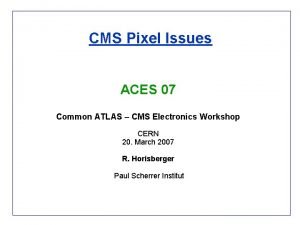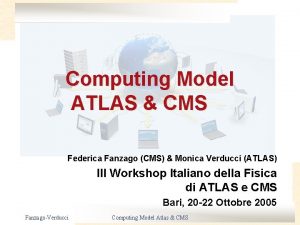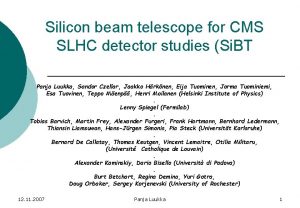The SLHC prospects at ATLAS and CMS 1




















- Slides: 20

The SLHC prospects at ATLAS and CMS 1) 2) 3) 4) 5) 6) Introduction Physics motivation LHC machine upgrade Experiment upgrades New inner trackers for SLHC Conclusions Ian Dawson, University of Sheffield EPS 2007, Manchester

Introduction ATLAS § ATLAS and CMS will exploit physics in Te. V regime. First collisions expected in 2008. Rich physics programme Higgs, SUSY, etc. CMS § Extend the physics potential of the LHC with a luminosity upgrade around ~2016

• Time scale of an LHC upgrade time to halve error integrated L Jim Strait, 2003 L at end of year Radiation damage limit ~700 fb-1 Hypothetical luminosity scenario ultimate luminosity design luminosity § Life expectancy of LHC inner-triplet (focusing) magnets and experiment’s inner trackers <10 years due to radiation damage. § Statistical error halving time exceeds 5 years by 2011 -2012. It is reasonable to plan a luminosity upgrade based on new inner-triplet focusing magnets around ~2015/2016

Physics motivation § The physics potential of a luminosity upgrade will be better known with Eur. Phys. J. C 39(2005)293 LHC data. In general: 1) Extend the mass reach by 0. 5 Te. V->1 Tev (increased statistics of high-x parton interactions) – Extra gauge bosons, heavy Higgsbosons, resonances in extradimension models, SUSY particles (if relatively heavy). For example, extra gauge bosons (W, Z like) appear in various extensions of the SM symmetry group. – Example of improved mass reach - taking into account CMS acceptance and e/ reconstruction efficiency and pile-up noise.

2) Increased precision in Standard Model Physics – – Triple and quartic gauge couplings Rare FCNC top decays Higgs couplings Strongly coupled vector boson scattering (if no Higgs) W g, Z Process WWW WWZ ZZW ZZZ WWWW WWWZ N(m. H=120 Ge. V) 2600 1100 36 7 5 0. 8 N(m. H=200 Ge. V) 7100 2000 130 33 20 1. 6 Number of multiple gauge boson events with leptonic final states - for a luminosity of 6000 fb-1. 3) Physics beyond SM (if relatively light and discovered at LHC). For example -SUSY Dark Matter? – – Extend particle spectrum Improve precision and access rare decay channels. W Eur. Phys. J. C 39(2005)293 Measure coupling of neutralino to Higgs. Requires 5 years of SLHC

LHC machine upgrade § Big challenge to increase luminosity by factor of ten. Machine R&D already started - long lead times. § Two scenarios currently being considered: 1. Improve beam focusing 2. Machine magnets inside experiments 25 ns or 50 ns bunch crossing Increase beam currents More demanding on machine 50 ns bunch crossing parameter symbol protons per bunch Nb [1011] bunch spacing Dt [ns] beam current I [A] longitudinal profile 25 ns, small b* 50 ns, long 1. 7 4. 9 25 50 0. 86 1. 22 Gauss Flat rms bunch length sz [cm] 7. 55 11. 8 beta* at IP 1&5 b* [m] 0. 08 0. 25 full crossing angle qc [mrad] 0 381 peak luminosity L [1034 cm-2 s-1] 15. 5 10. 7 peak events per crossing initial lumi lifetime effective luminosity (Tturnaround=5 h) 294 t. L [h] L [1034 cm-s-1] 403 2. 2 3. 6 4. 5 3. 5

25 ns spacing 50 ns spacing average luminosity § The 25 ns scenario will require magnets inside the experiments! § Peak luminosities may be too difficult for experiments to cope with - possibility of ”luminosity levelling” being explored. § Peak luminosities different for 25 ns versus 50 ns scenarios, but average luminosity similar.

Experiment upgrades § From the LHC to the SLHC … 1032 cm-2 s-1 1033 1034 § Both ATLAS and CMS in process of determining upgrade requirements. 1035 CMS

Muon chambers ATLAS Forward calorimeters § In general, most of calorimetry should be OK § FCAL (|η|>3. 1) particularly subject to beam radiation - Simulations show possible heating of LAr - Improve cooling? Or new “warm” FCAL? § Background rates very uncertain (factor ~5 x) § Need LHC experience § Effect of slim quads? § Use existing chambers as far as possible § Beryllium beampipe will reduce by factor of 2. New FCal?

Level 1 trigger § CMS There may not be enough rejection power using the muon and calorimeter triggers to handle the higher luminosity conditions at SLHC – Level 1 Muon Trigger has no discrimination for p. T > 20 Ge. V/c, therefore problem to keep Level 1 at ~100 k. Hz. – Adding tracking information at Level 1 gives the ability to adjust PT thresholds High momentum tracks are straighter so pixels line up γ Search Window 2 layers about 1 mm apart could communicate Calorimeters § Electromagnetic calorimeters should be OK at SLHC. § Hadronic calorimeter scintillator may suffer radiation damage for >2 - R&D required - Impact on forward region not clear if machine magnet insertions? Muon system § In general, expected to be quite robust, but some electronics “less” radiation hard and most likely need replacing. § As with ATLAS, need experience with running at LHC.

New trackers for SLHC § Both ATLAS and CMS need new inner trackers § Started looking at new layouts. Simulations crucial to ascertain: – Occupancies – Material effects – Track reconstruction performance Fluences at larger radii dominated by neutron-albedo, greatest near endcaps. Fluences at small radii dominated by particles from interaction point. (ATLAS preliminary) § Silicon trackers at LHC use mainly p-in-n sensors - requires full depletion high voltages already at LHC. § Move over to n-in-p at SLHC - can operate underdepleted (lower costs than n-in-n).

§ For innermost layers - new technology required 3 D silicon sensors ? Uses MEMS (Micro Electro Mechanical Systems) technology to engineer structures. Both electrode types are processed inside the detector bulk instead of being implanted on the wafer's surface. Electric field between electrodes - shorter signal collection distances compared with planar devices: – – – Lower depletion voltage (and therefore power) Faster and more efficient charge collection. Large scale production? Timescale? Cost ? Gas ? CVD Diamond ? Eg GOSSIP (micromegas) low mass but gas issues such as sparking? Now well established with several applications (eg beam conditions monitoring) – – – Large band gap and strong atomic bonds give excellent radiation hardness Low leakage current and capacitance = low noise Large band gap means ~2 less signal than Si for same X 0 Planar silicon sensors ? § Use conventional planar silicon n-in-p or n -in-n should new technologies not be ready

Conclusions § The implications of a major luminosity upgrade (SLHC) sometime around 2015 -2016 are being studied by the LHC machine and experiments. - Significantly extend physics potential of LHC - Work started already - long lead times! - But the main priority is physics exploitation of the LHC. § The baseline bunch crossing rate at the SLHC is 20 MHz, with 40 MHz as a backup. - The 80 MHz option is no longer considered due to beam heating. § ATLAS and CMS need new inner trackers New technologies being investigated § CMS will need to revise Level 1 trigger strategy. § ATLAS forward calorimeter may need upgrading, as well as some of the muon system. § A better understanding of upgrade requirements for ATLAS and CMS will be gained from running at LHC.

Backup slides

The European strategy for particle physics “The LHC will be the energy frontier machine for the foreseeable future, maintaining European leadership in the field; the highest priority is to fully exploit the physics potential of the LHC, resources for completion of the initial programme have to be secured such that machine and experiments can operate optimally at their design performance. A subsequent major luminosity upgrade (SLHC), motivated by physics results and operation experience, will be enabled by focussed R&D; to this end, R&D for machine and detectors has to be vigorously pursued now and centrally organized towards a luminosity upgrade by around 2015. ” (http: //council-strategygroup. web. cern. ch/council-strategygroup/)

• Luminosity levelling etc. 25 ns 50 ns average luminosity The relatively fast luminosity decay and high multiplicity call for Luminosity Leveling. …but the issue is how to do it efficiently: • dynamic beta*: uses existing hardware; probably complex due to large number of side-effects in IR’s AND arcs. • dynamic bunch length: needs new RF; possible side effects in whole machine related to modification of peak current. • dynamic crossing angle: using the early separation hardware, no side effects identified. Even better: crabbing.

§ Possible sensor technology for the SLHC tracker Long strips (present p+-n or n+-p) n+-p pixels Short strips (n+-p) Pixel b-layer (3 D? Diamond? thin-Si? Gas? ) § The most challenging will be engineering work (cooling, cabling, shielding, other services)

• Planar silicon n-in-p or n-in-n can still play a role for inner most layers should new technologies not be ready – Tried and tested solution but high operating voltages unless thin ?

Simulations for the inner tracker § 1 Me. V fluences obtained by convolving particle spectra predicted by FLUKA 2006 with “displacement-damage” curves (RD 48). 1 Me. V equivalent neutron fluences assuming an integrated luminosity of 3000 fb-1 and 5 cm of moderator lining the calorimeters. § av 18 is current baseline geometry for upgrade studies § 5 cm neutron moderator lining all the calorimeters § no tracker material The beneficial moderating effect of the TRT is lost in an all silicon system. Can be recovered with 5 cm of moderator lining barrel (as shown in Genova).

Parameterisation of 1 Me. V-neq fluences § Several requests to parameterise inner tracker backgrounds. Z(cm) 0 a 1 a 2 a 3 a 4 1. 4 x 1017 3. 7 x 1015 1. 7 x 1014 -1. 0 x 1012 150 7. 0 x 1016 9. 5 x 1015 9. 7 x 1013 -5. 7 x 1011 300 4. 9 x 1016 1. 2 x 1016 3. 0 x 1014 -2. 0 x 1012 Fluences at small radii dominated by particles from interaction point. § Parameterise also pion and neutron contributions separately. Fluences at larger radii dominated by neutron-albedo, greatest near endcaps. § Use these types of plots for future investigations (Eg moderator design, impact of extra material etc. )
 Quantum computing: progress and prospects
Quantum computing: progress and prospects The principal contrast in the passage is between
The principal contrast in the passage is between Prospects of agriculture in bangladesh
Prospects of agriculture in bangladesh World population prospects
World population prospects Prospects preposition
Prospects preposition Hát kết hợp bộ gõ cơ thể
Hát kết hợp bộ gõ cơ thể Ng-html
Ng-html Bổ thể
Bổ thể Tỉ lệ cơ thể trẻ em
Tỉ lệ cơ thể trẻ em Voi kéo gỗ như thế nào
Voi kéo gỗ như thế nào Chụp phim tư thế worms-breton
Chụp phim tư thế worms-breton Hát lên người ơi
Hát lên người ơi Các môn thể thao bắt đầu bằng từ đua
Các môn thể thao bắt đầu bằng từ đua Thế nào là hệ số cao nhất
Thế nào là hệ số cao nhất Các châu lục và đại dương trên thế giới
Các châu lục và đại dương trên thế giới Công thức tính thế năng
Công thức tính thế năng Trời xanh đây là của chúng ta thể thơ
Trời xanh đây là của chúng ta thể thơ Cách giải mật thư tọa độ
Cách giải mật thư tọa độ 101012 bằng
101012 bằng Phản ứng thế ankan
Phản ứng thế ankan Các châu lục và đại dương trên thế giới
Các châu lục và đại dương trên thế giới
